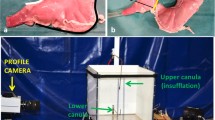Abstract
There are two main problems in research on gastric surgery: life-threatening complications and clinical follow-up. Computational fluid dynamics can be used as a tool to identify the source of these problems and provide solutions to improve gastric resection procedures. In this study, geometric configurations that can be applied in surgery for Billroth-II gastric resection with jejunojejunostomy anastomosis were presented. The effects of these geometric configurations on the anastomotic leak and leakage of pancreatic juice and bile into the stomach (duodenogastric reflux) risks were investigated numerically. Finite volume method was preferred for numerical analyses. The SIMPLE algorithm for the pressure–velocity coupling and the second-order scheme for the pressure correction were applied. First-order UPWIND and second order UPWIND schemes were used in the mass transport and discretization of conservation equations, respectively. Numerical analyzes were performed for different gastroenterostomy anastomosis suture angles (α), the ratios of afferent loop length to suture width (L/D), and the ratio of the distance between the gastroenterostomy and jejunojejunostomy anastomoses to the suture width (H/D). For both when the stomach was mostly full or empty, it was determined that the best results were obtained for α = 30°, H/D = 2.5 and L/D = 5 in terms of anastomotic leak and duodenogastric reflux risks. It was concluded that in Billroth-II gastric resection with jejunojejunostomy anastomosis, giving an angle with positive slope to the suture, increasing the afferent loop length, and keeping the jejunojejunostomy anastomosis at a distance of at least 2.5 times the suture width from the gastroenterostomy anastomosis reduces the risks of anastomotic leak and duodenogastric reflux.












Similar content being viewed by others
Abbreviations
- c :
-
Mass concentration (kg/m3)
- D :
-
Suture width (m)
- D diff :
-
Diffusion coefficient (m2/s)
- H :
-
Distance between two anastomoses (m)
- L :
-
Afferent loop length (m)
- \({\dot{m}}\) :
-
Volume flow rate (ml/day)
- P :
-
Pressure (Pa)
- v :
-
Chyme velocity (m/s)
- α :
-
Angle (°)
- ρ :
-
Density (kg/m3)
- µ :
-
Dynamic viscosity (Pa s)
- ave:
-
Average
- diff:
-
Diffusion
- pj:
-
Pancreatic juice and bile
- s:
-
Saliva
References
Swan R, Miner TJ (2006) Current role of surgical therapy in gastric cancer. World J Gastroenterol WJG 12:372
Sano T, Sasako M, Yamamoto S, Nashimoto A, Kurita A, Hiratsuka M, Tsujinaka T, Kinoshita T, Arai K, Yamamura Y (2004) Gastric cancer surgery: morbidity and mortality results from a prospective randomized controlled trial comparing D2 and extended para-aortic lymphadenectomy—Japan Clinical Oncology Group study 9501. J Clin Oncol 22:2767–2773
Steger J, Jell A, Ficht S, Ostler D, Eblenkamp M, Mela P, Wilhelm D (2022) Systematic review and meta-analysis on colorectal anastomotic techniques. Ther Clin Risk Manag 18:523–539
Thapa P, Nagarkoti K, Lama T, Maharjan D, Tuladhar M (2011) Early enteral feeding in intestinal anastomosis. J Nepal Health Res Counc 9:1–5
Kang K-C, Cho GS, Han SU, Kim W, Kim H-H, Kim M-C, Hyung WJ, Ryu SY, Ryu SW, Lee HJ (2011) Comparison of Billroth I and Billroth II reconstructions after laparoscopy-assisted distal gastrectomy: a retrospective analysis of large-scale multicenter results from Korea. Surg Endosc 25:1953–1961
Hirao M, Takiguchi S, Imamura H, Yamamoto K, Kurokawa Y, Fujita J, Kobayashi K, Kimura Y, Mori M, Doki Y (2013) Comparison of Billroth I and Roux-en-Y reconstruction after distal gastrectomy for gastric cancer: one-year postoperative effects assessed by a multi-institutional RCT. Ann Surg Oncol 20:1591–1597
Ordahl N, Ross F, Baker D Jr (1955) The failure of partial gastrectomy with gastroduodenostomy in the treatment of duodenal ulcer. Surgery 38:158–168
Santoro E (2005) The history of gastric cancer: legends and chronicles. Gastric Cancer 8:71
Cvetkovic AM, Milasinovic DZ, Peulic AS, Mijailovic NV, Filipovic ND, Zdravkovic ND (2014) Numerical and experimental analysis of factors leading to suture dehiscence after Billroth II gastric resection. Comput Methods Programs Biomed 117:71–79
Shin C-I, Kim SH (2020) Normal and abnormal postoperative imaging findings after gastric oncologic and bariatric surgery. Korean J Radiol 21:793
Pirhan Y, Gök K, Gök A (2020) Comparison of two different bowel anastomosis types using finite volume method. Comput Methods Biomech Biomed Eng 23:323–331
Mulholland MW et al (2014) Operative techniques in surgery. Lippincott Williams & Wilkins, Philadelphia
Robert ZM (2010) Zollinger’s Atlas of surgical operations. McGraw-Hill Medical, New York
Author information
Authors and Affiliations
Corresponding author
Additional information
Technical Editor: Daniel Onofre de Almeida Cruz.
Publisher's Note
Springer Nature remains neutral with regard to jurisdictional claims in published maps and institutional affiliations.
Rights and permissions
Springer Nature or its licensor (e.g. a society or other partner) holds exclusive rights to this article under a publishing agreement with the author(s) or other rightsholder(s); author self-archiving of the accepted manuscript version of this article is solely governed by the terms of such publishing agreement and applicable law.
About this article
Cite this article
Pirhan, Y., Uğur, L. & Kurşun, B. Geometric modification of Billroth-II gastric resection with computational fluid dynamics (CFD) method: assessment of anastomotic leak and duodenogastric reflux risks. J Braz. Soc. Mech. Sci. Eng. 46, 298 (2024). https://doi.org/10.1007/s40430-024-04852-8
Received:
Accepted:
Published:
DOI: https://doi.org/10.1007/s40430-024-04852-8




